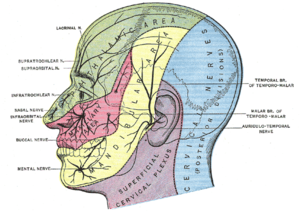Orofacial pain
| Orofacial pain | |
|---|---|
 |
|
| Dermatomes of the face. | |
| Classification and external resources | |
| MeSH | D005157 |
Orofacial pain is a general term covering any pain which is felt in the mouth, jaws and the face. Orofacial pain is a common symptom, and there are many causes. It is estimated that over 95% of cases of orofacial pain result from dental causes (i.e. toothache caused by pulpitis or a dental abscess). After dental pain, the second most common cause of orofacial pain is temporomandibular joint dysfunction (TMD, pain-dysfunction syndrome). All other causes of orofacial pain are rare in comparison, although the full differential diagnosis is extensive.
Orofacial pain has been defined as "pain localized to the region above the neck, in front of the ears and below the orbitomeatal line, as well as pain within the oral cavity; [including] pain of dental origin and temporomandibular disorders". However, some orofacial pain conditions may involve areas outside this region, e.g. temporal pain in TMD. Toothache, or odontalgia, is any pain perceived in the teeth or their supporting structures (i.e. the periodontium). Toothache is therefore a type of orofacial pain. Craniofacial pain is an overlapping topic which includes pain perceived in the head, face, and related structures, sometimes including neck pain.
There are 4 main classifications which attempt to classify the causes of orofacial pain, but no system is universally accepted.
It has also been suggested that the most basic etiologic classification of orofacial pain is into the following 3 groups:
Orofacial pain is common problem. For example, in the United States, one report estimated that 22% of the general population had suffered from some form of facial pain at some point in the 6-month period before questioning, of which 12% was toothache. In the United Kingdom, 7% of the general population reported having some degree of chronic orofacial pain. Other reports indicate a prevalence of 10–15% for TMD in the general population.
...
Wikipedia
